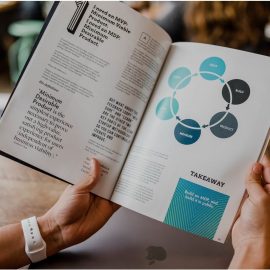

This article is an excerpt from the Shortform book guide to "Cues" by Vanessa Van Edwards. Shortform has the world's best summaries and analyses of books you should be reading.
Like this article? Sign up for a free trial here.
Is charisma something you’re born with, or can it be learned? What’s the secret to becoming more influential and respected in your personal and professional lives?
Cues, a book by Vanessa Van Edwards, contends that anyone can boost their charisma by understanding and strategically using verbal and nonverbal cues. She explains that charisma is a balance of warmth and competence, which we can project through our words, body language, and personal branding.
Continue reading for an overview of this practical book.
Cues Book Overview
Do you have helpful skills and insights to share with the world, yet find yourself undervalued and ignored at work and in your social life? According to Cues, a book by Vanessa Van Edwards, the problem might be that you’re not projecting charisma—the quality that makes others pay attention to you. Without charisma, you won’t get your ideas across or have an impact on others, which can hold you back both personally and professionally. However, Van Edwards says that, by adopting charismatic cues, anyone can begin to convey charisma and make their mark on the world.
Van Edwards is a communications expert and the best-selling author of Captivate. She researches human behavior at her research lab, Science of People, and trains others to improve their lives by understanding human behavior.
In this overview of Cues (published in 2022), we’ll discuss Van Edwards’s definition of charisma and explain how people convey different levels of charisma through verbal and nonverbal cues. Then, we’ll explore some cues you can adapt to improve your unique charismatic style. Finally, we’ll discuss the cues you should mitigate or avoid to reinforce your charismatic image.
What Is Charisma?
Van Edwards explains that charisma is a balance of warmth and competence. When you meet someone, you first subconsciously judge their warmth (approachability, empathy, and kindness), then their competence (skill, confidence, and air of authority). As you interact further, you continue subconsciously judging them along these lines.
You form these judgments by perceiving their cues: verbal, nonverbal (behavioral), and symbolic signals of meaning—like kind words, crossed arms, and even the color of their shirt. Van Edwards says your brain has evolved to interpret these cues in only a few milliseconds. This helps you immediately determine whether others are trustworthy (via warmth cues) and whether you can rely on them as competent allies or leaders (via competence cues).
Van Edwards describes charisma on a spectrum—you might have no charisma, some charisma, or high charisma. She also lists a range of problems (and advantages) you may have interacting with others, depending on where you fall on that spectrum. Let’s explore the spectrum of charisma now.
No Charisma: Low Competence, Low Warmth
If you fail to display both warmth and competence cues, you have no charisma. Remember that others form a subconscious first impression of you based on your charismatic cues. You may have a warm and competent personality, but if you don’t demonstrate these traits via cues, you’ll project a cold, uncaring, irrational, and incompetent image. According to Van Edwards, this image damages your credibility. People won’t be able to connect with you or see the value in what you have to offer, whether that’s strategic insight or emotional support. This undermines your ability to influence others and build relationships with them.
Some Charisma: High Competence, Low Warmth
If you’re a highly competent person, you likely value skillfulness, expertise, and problem-solving abilities. You probably care that others respect you for your talents and see you as an authority, so you (unconsciously) use competence cues to project such an image. However, Van Edwards says that when you naturally favor competence cues, you may neglect to use enough warmth cues. To illustrate, former Chancellor of Germany Angela Merkel falls into this category: She was known for her competent leadership, but both her supporters and detractors acknowledged her lack of public emotion.
If your cues suggest you’re highly competent, you have some charisma—for example, people might be more willing to hear out your ideas. But since you don’t use enough warmth cues, Van Edwards says others may see you as cold and uncaring. As a result, they might find it hard to work with you, or you may have trouble making friends.
Some Charisma: Low Competence, High Warmth
If you’re a very warm person, you likely value building genuine relationships with others and seeking to truly understand them. You probably care whether other people approve of you, feel comfortable with you, and enjoy spending time with you. Van Edwards says that as a result, most of the cues you (unconsciously) project are warmth cues, and you may neglect to use enough competence cues. Food Network host Guy Fieri exemplifies this pattern: He’s beloved for his good-natured enthusiasm, but some critics question his competence as a restaurateur.
The warmth cues you project give you some charisma—for example, people may be more willing to share personal secrets with you. However, Van Edwards explains that since you don’t display enough competence cues, others may see you as irrational, inept, or difficult to respect. This can lead them to shut down your ideas, talk over you, or override your boundaries—and since you care so much about their approval, you might find yourself tolerating their inappropriate behavior without protest.
High Charisma: High Competence, High Warmth
Someone who expresses both warmth and competence cues is highly charismatic. Van Edwards says that since you project an image that’s both highly competent and very warm, you enjoy all the benefits associated with each trait—people subconsciously trust and want to collaborate with you. For example, say that you’re the only expert in finance at your job. If you project a warm, competent image, people will respect your authority and enjoy working alongside you. This will make them feel more comfortable deferring to your expertise and seeking your guidance when they need it.
However, Van Edwards says most people aren’t highly charismatic—they tend to be dominant in one area (warmth or competence) at the expense of the other, or they may be lacking in both areas. Even if you feel that you’re highly charismatic, there may still be room to grow—learning more about how cues work can allow you to optimize your charisma by appearing warmer or more competent in different situations. For example, you might choose to use extra warmth cues during a first date to help you seem friendly and approachable.
How Understanding Cues Improves Your Charisma
Van Edwards says anyone can become more charismatic by understanding and strategically adopting warmth and competence cues. But how does this improve your charisma? Van Edwards’s theory depends on the cycle of cue communication, which has three steps: perceiving, absorbing, and conveying. First, when you perceive someone’s cue, you automatically begin trying to understand what it means—what message are they sending you? After you’ve perceived their cue, you absorb it—it becomes part of your understanding of the situation, and you have an emotional reaction to this update. Finally, you convey a message back to the other person, either automatically or thoughtfully—again, via your cues.
To illustrate, say your friend frowns at a joke you’ve made. Based on this cue, you might perceive that they found your joke offensive. As you absorb that information, you might feel embarrassed and make a mental note to yourself that the language you used was inappropriate. Then, you might apologize for the bad joke, using a verbal cue like imbuing your voice with emotion to convey your sincerity. (Then, the cycle continues—they perceive your cues, absorb the information you’ve conveyed, and send a message back, like accepting your apology.)
Van Edwards argues that, the more you know about cues, the more likely you are to succeed at each step of this communicative process. The ability to recognize and understand common cues helps you perceive them accurately, which means you’re more likely to absorb the right information and have an appropriate emotional response—for example, you won’t misinterpret your friend’s frown as approval, feel pleased, and decide to repeat the joke to another friend.
Finally, armed with your knowledge of cues and a decent understanding of the situation you’re in, you can choose to display the cues that project a charismatic image. This helps you communicate effectively and shape the exchange in ways that benefit you, since people are more willing to trust and collaborate with you if you seem charismatic. For example, intentionally conveying more warmth via cues might help you recover from a faux pas (such as an offensive joke).
Adopt These Charismatic Cues
Now that you know how understanding cue communication can benefit you, let’s discuss the verbal and nonverbal cues Van Edwards says can boost your charisma. In every case, Van Edwards recommends that you only adopt cues that feel natural to you. If you fake a cue, others will detect the artifice and distrust you, damaging your charisma.
Charismatic Verbal Cues
Verbal cues are cues conveyed through speech or text. They include word choice cues (your vocabulary and punctuation choices) and vocal cues (techniques that make your spoken voice sound more charismatic). We’ll cover all these cues.
Charismatic Word Choice Cues
Choose your words carefully. Van Edwards explains that the words you use carry both surface-level and hidden information. For example, “teaming up” and “working jointly” on a project have a similar surface meaning, but the former sounds warmer than the latter. To maximize your charisma, use a blend of warm and competent words.
Consider your emoji and punctuation use. Van Edwards says that in text and email, emojis and exclamation points signal warmth. She refers readers to Science of People’s emoji guide, where she explains when (and when not) to use 45 different emojis.
Imitate others’ word choice. Van Edwards says if you subtly imitate someone’s word choice, they’ll feel validated, which improves your rapport with them. If they greet you in a certain way, return the same greeting. If they use warm words like “love” or “encourage,” use the same or similar words in your response. When communicating over text, you can even mimic their punctuation style.
Use charismatic language at the start and end of professional gatherings. Van Edwards explains that using charismatic language (which signals both warmth and competence) at the start and finish of professional gatherings can inspire higher productivity and engagement. Here’s a pop culture example: On the TV show Grey’s Anatomy, charismatic surgeon Derek Shepherd often begins surgeries with the phrase, “It’s a beautiful day to save lives.” The “beautiful day” portion conveys warmth, while “save lives” conveys competence.
Use “touchy” language when you’re not face-to-face. It can be difficult to signal warmth during remote communication. Van Edwards says telling others you wish you could touch them with phrases like “Virtual first bump!” or “Sending you a kiss!” can make you seem warm.
Vocal Cues That Project Warmth
Speak with feeling. Many people mistakenly believe that speaking with feeling—that is, letting your emotions shine through your speech—undermines your credibility. Van Edwards explains that the opposite is true: When you speak with feeling, your voice changes in subtle, momentary ways. These changes communicate authenticity, which makes listeners more likely to engage with the ideas you’re sharing.
Convey your interest when others are speaking. Van Edwards says you can use two types of vocal cues when others are speaking to show them you’re engaged: interjections (for example, “That’s wild!” as someone tells a fascinating story) and affirmative sounds (like “huh!” in response to something that surprises you). You can also imitate the interjections and affirmative sounds others use in conversation with you to build rapport.
Vocal Cues That Project Competence
Drop your voice’s pitch as low as you can comfortably go. The deeper your voice, the more confident you’ll seem. Van Edwards stresses that comfort is key here—if you drop your pitch too low, it may be hard to speak consistently and others might perceive you as inauthentic.
Project your voice. Breathe in deeply, then speak loudly as you exhale (but not before you exhale, or you’ll run out of breath before you finish speaking). Van Edwards explains that this will help you avoid speaking too quietly or with vocal fry (a gravelly voice quality), two vocal cues that signal a lack of self-confidence.
Vary your volume to match the content of your speech. Van Edwards suggests that this approach signals that your emotions and ideas are aligned, creating higher confidence in your claims. Raise your volume to emphasize your passion. Lower your volume to create the sense that you’re including your listeners in something private and important.
Pause instead of using filler words. It’s common to use filler words like “um” and “so” to buy time when you’re not sure what to say next and don’t want listeners to mistakenly think you’re done talking. However, Van Edwards says that filler words signal low confidence in the content of your speech, which encourages others to interrupt you. She recommends that you replace filler words with pauses, but only in the middle of a sentence, not at the end. Pausing mid-sentence creates a sense of anticipation that draws listeners in, while pausing at the end suggests that you’re done speaking.
Charismatic Nonverbal Cues
Now that we’ve covered verbal cues, let’s explore the nonverbal cues Van Edwards describes. We’ll start with behavioral cues (body language, facial expressions, and other physical techniques) that project warmth, competence, and overall charisma (both warmth and competence). Then, we’ll discuss personal branding (visual cues that can evoke charismatic associations).
Behavioral Cues That Project Warmth
Smile often, slowly, and genuinely. Van Edwards explains that genuine smiling is one of the most effective ways to project warmth. They’re also contagious—when you smile at someone, they’re likely to smile back at you, which facilitates social bonding. Smiling slowly can signal true delight and inspire laughter, another contagious warmth cue that strengthens your connection with someone. However, you should only smile genuinely—Van Edwards warns that artificial smiles don’t help you seem warmer, since it can be easy for others to tell they’re disingenuous.

———End of Preview———
Like what you just read? Read the rest of the world's best book summary and analysis of Vanessa Van Edwards's "Cues" at Shortform.
Here's what you'll find in our full Cues summary:
- Which verbal and nonverbal cues will make you more charismatic
- How to make yourself seen in your professional and social lives
- Why head tilts are cuter in dogs than in humans






